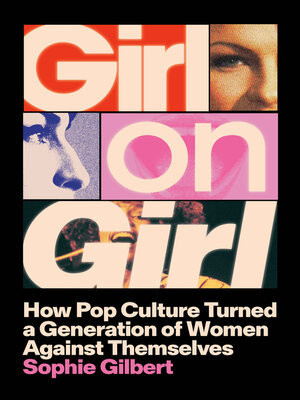Girl on Girl
ebook ∣ How Pop Culture Turned a Generation of Women Against Themselves
By Sophie Gilbert

Sign up to save your library
With an OverDrive account, you can save your favorite libraries for at-a-glance information about availability. Find out more about OverDrive accounts.
Find this title in Libby, the library reading app by OverDrive.



Search for a digital library with this title
Title found at these libraries:
| Library Name | Distance |
|---|---|
| Loading... |
From Atlantic critic and Pulitzer Prize finalist Sophie Gilbert, a blazing critique of how early-aughts pop culture turned women and girls against each other—and themselves—with disastrous consequences. An urgent read that addresses questions around the current regression of feminism.
When did feminism lose its way? This question feels increasingly urgent in a moment of reactionary cultural and legislative backlash, when widespread uncertainty about the movement’s power, focus, and currency threatens decades of progress.
Sophie Gilbert, a staff writer at The Atlantic and finalist for the Pulitzer Prize in criticism, provides one answer, identifying an inflection point in the late 1990s and early 2000s when the energy of third-wave and “riot grrrl” feminism collapsed into a regressive period of hyper-objectification, sexualization, and infantilization. Gilbert mines the darker side of nostalgia, training her keen analytic eye on the most revealing cultural objects of the era, across music, film, television, fashion, tabloid journalism, and more. What she recounts is harrowing, from the unattainable aesthetic of Victoria’s Secret ads and explicit music videos to a burgeoning internet culture vicious towards women in the spotlight and damaging for those who weren’t. Gilbert tracks many of the period’s dominant themes back to the explosion of internet porn, tracing its widespread influence as it began to pervade our collective consciousness.
Gilbert paints a devastating picture of an era when a distinctly American confluence of excess, materialism, and power-worship collided with the culture’s reactionary, puritanical, and chauvinistic currents. Amidst a collective reconsideration of the way women are treated in public, Girl on Girl is a blistering indictment of the matrix of misogyny that undergirded the cultural production of the early twenty-first century, and how it continues to shape our world today.
When did feminism lose its way? This question feels increasingly urgent in a moment of reactionary cultural and legislative backlash, when widespread uncertainty about the movement’s power, focus, and currency threatens decades of progress.
Sophie Gilbert, a staff writer at The Atlantic and finalist for the Pulitzer Prize in criticism, provides one answer, identifying an inflection point in the late 1990s and early 2000s when the energy of third-wave and “riot grrrl” feminism collapsed into a regressive period of hyper-objectification, sexualization, and infantilization. Gilbert mines the darker side of nostalgia, training her keen analytic eye on the most revealing cultural objects of the era, across music, film, television, fashion, tabloid journalism, and more. What she recounts is harrowing, from the unattainable aesthetic of Victoria’s Secret ads and explicit music videos to a burgeoning internet culture vicious towards women in the spotlight and damaging for those who weren’t. Gilbert tracks many of the period’s dominant themes back to the explosion of internet porn, tracing its widespread influence as it began to pervade our collective consciousness.
Gilbert paints a devastating picture of an era when a distinctly American confluence of excess, materialism, and power-worship collided with the culture’s reactionary, puritanical, and chauvinistic currents. Amidst a collective reconsideration of the way women are treated in public, Girl on Girl is a blistering indictment of the matrix of misogyny that undergirded the cultural production of the early twenty-first century, and how it continues to shape our world today.







